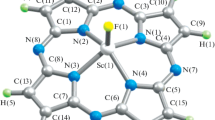Abstract
Geometry and thermodynamic characteristics of complexes X2MYH2 (M = Al, Ga, In; X = F, Cl, Br, I; Y = N, P, As) and their components were found by the B3LYP density functional method with the LANL2DZ(d,p) basic set. The nitrogen complexes X2MNH2 have a planar structure, whereas the phosphorus and arsenic complexes are pyramidal. Upon HX elimination, the dissociation energy of the M-Y bonds considerably increases (by 150-270 kJ mol- 1), which makes the dissociation of X2MYH2 into components thermodynamically unfeasible even at temperatures about 1000°C. A linear correlation between the dissociation enthalpies of M-Y bonds in the X3MYH3 and X2MYH2 complexes was found for each central atom M, which makes it possible to estimate the dissociation enthalpies of coordination-unsaturated compounds of the Group IIIa elements from the dissociation enthalpies of their coordination-saturated analogs. The enthalpies of dimerization of X2MYH2 fall in the range from 40 (Y = P, As) to 260 kJ mol- 1 (Y = N), which makes the process X3MNH3 = [X2MNH2]2 + HX with the retention of the metal-nitrogen bond more favorable than the dissociation of the initial complex into the components. Thus, dimers [X2MNH2]2 can be intermediates in chemical deposition of nitrides from the gas phase of donor-acceptor complexes.
Similar content being viewed by others
REFERENCES
Tirtowidjojo, M. and Pollard, R., J. Cryst. Growth, 1988, vol. 93, no. 1, pp. 108-114.
Kim, H.J., Egashira, Y., and Komiyama, H., Appl. Phys. Lett., 1991, vol. 59, no. 8, pp. 2521-2523.
Egashira, Y., Kim, H.J., and Komiyama, H., J. Am. Ceram. Soc., 1994, vol. 77, no. 10, pp. 2009-2016.
Timoshkin, A.Yu., Suvorov, A.V., and Schaefer, H.F., Zh. Obshch. Khim., 1998, vol. 68, no. 7, pp. 1138-1147.
Frisch, M.J., Trucks, G.W., Schlegel, H.B., Gill, P.M.W., Johnson, B.G., Robb, M.A., Cheeseman, J.R., Keith, T., Petersson, G.A., Montgomery, J.A., Raghavachari, K., Al-Laham, M.A., Zakrzewski, V.G., Ortiz, J.V., Forestman, J.B., Cioslowski, J., Stefanov, B.B., Nanayakkara, A., Challacombe, M., Peng, C.Y., Ayala, P.Y., Chen, W., Wong, M.W., Andres, J.L., Replogle, E.S., Gomperts, R., Martin, R.L., Fox, D.J., Binkley, J.S., Defrees, D.J., Barker, J., Stewart, J.P., Head-Gordon, M., Gonzalez, C., and Pople, J.A., GAUSSIAN 94, Revision C.3, Pittsburgh: Gaussian, 1995.
Hay, P.J. and Wadt, W.R., J. Chem. Phys., 1985, vol. 82, no. 1, pp. 270-283.
Wadt, W.R. and Hay, P.J., J. Chem. Phys., 1985, vol. 82, no. 1, pp. 284-298.
Hay, P.J. and Wadt, W.R., J. Chem. Phys., 1985, vol. 82, no. 1, pp. 299-310.
Becke, A.D., J. Chem. Phys., 1993, vol. 98, no. 10, pp. 5648-5652.
Lee, C., Yang, W., and Parr, R.G., Phys. Rev. B, 1988, vol. 37, no. 1, pp. 785-793.
Jasien, P. G., J. Phys. Chem., 1992, vol. 96, no. 12, pp. 9273-9280.
Handbook of Chemistry and Physics, Lide, D.R., Ed., Boca Raton, FL, 1995.
Timoshkin, A.Y., Bettinger, H.F., and Schaefer, H.F., III, J. Am. Chem. Soc., 1997, vol. 119, no. 24, pp. 5668-5678.
Author information
Authors and Affiliations
Rights and permissions
About this article
Cite this article
Timoshkin, A.Y., Suvorov, A.V. & Schaefer, H.F. Structural and Thermodynamic Characteristics of Compounds X2MYH2 (M = Al, Ga, In; X = F, Cl, Br, I; Y = N, P, As) Formed by Hydrogen Halide Elimination from Donor-Acceptor Complexes X3MYH3. Russian Journal of General Chemistry 71, 8–14 (2001). https://doi.org/10.1023/A:1012308801720
Issue Date:
DOI: https://doi.org/10.1023/A:1012308801720




